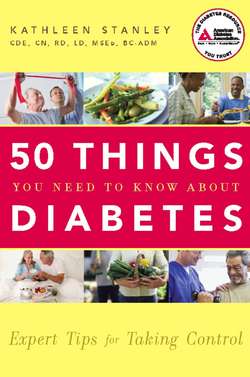Читать книгу 50 Things You Need to Know about Diabetes - Kathleen Stanley - Страница 6
На сайте Литреса книга снята с продажи.
ОглавлениеPREFACE
As diabetes care has advanced over the years with new gadgets, tools, and methods, one principle has remained the same: Education is the key to successful diabetes self-care and optimal health. The new, little bright-colored meters are cool, and insulin delivery devices (pumps and pods) are sophisticated, but if you don’t know how to solve problems for yourself, these tools can only help so much.
Diabetes education can come from formal training with a health care professional—a physician, certified diabetes educator (CDE), nurse, registered dietitian (RD), or pharmacist—and from informal experiences in life. Qualified health care professionals can teach basic self-care strategies and provide useful information. But real life situations, such as eating out at a restaurant for the first time after being diagnosed, will test your ability to apply your knowledge to different settings and situations. There are challenges to face daily, and some are easier to conquer than others.
The goal of this book is to help make a link between the skills you learn from health care professionals and the real-life situations you will face. The intent of the book is not to replace diabetes education classes, as you need to have a basic understanding of diabetes and a basic set of skills. Learning how to test your blood glucose, develop a meal plan, or take medications are best learned in a formal setting with hands-on instruction. But your body will also teach you how it works and responds to situations, which may vary slightly from the theory you learned in class, or even in this book. You will need to develop your own unique strategies and solutions for certain circumstances along the way at times.
Diabetes care is constantly evolving and improving. New products are developed each year that can directly improve your quality of life, and you will want to be in the know about these new products. You will also learn to modify your own management strategies when an outcome wasn’t what you expected or planned for. Sometimes in diabetes, you have to make an educated guess to predict what will happen to your blood glucose in a situation. Your personal blood glucose monitor device is an indispensable tool to use to help you collect information about outcomes and learn from past unexpected situations to face the new ones.
Finally, be open to making changes in your own care as you live with diabetes. Your body will go through natural changes each year, and these changes will require adjustments on your part. Use resources, such as your personal health care team and information from the American Diabetes Association (ADA), to help you make informed decisions about your health. Share any successful tips you have learned with others who live with diabetes, too. Imparting strategies and ideas you have learned to others can help you build a support network and improve your own knowledge. Isn’t it often said that teachers learn more from their students than the other way around?
The truth is that you will be a lifelong student in the subject of diabetes. But it will be a journey that is worthwhile. My hope is that this book can help. In the following pages, I provide useful tips derived from professional experts, as well as “real life” people. The result is the first “50 Things” you should know about diabetes.
—Kathleen Stanley, CDE, RD, LD, CN, MSEd, BC-ADM
